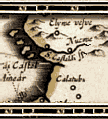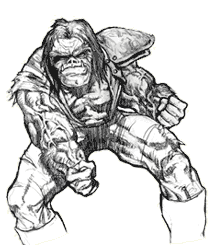







|
|
|
|
The average ogre today achieves a height of no more than 150 inches, or 380 centimeters; this is a far cry from the giants of yesteryear, who could sometimes measure longer in the bone of the thigh alone. They weigh roughly 3000 stone, this mass being mainly dense muscle. It's difficult to ascertain the natural lifespan of these creatures, as ogres are so inimical to life that they are killed almost immediately by any other race that encounters them, but the average age of the ogre cadavers I have examined seems to be some 200 years. How long they may live if they are left to themselves, I cannot say. Every specimen I have seen has been dead by violence.
From the standpoint of Natural History, oddly enough, ogres may have the prior claim to the peaks of the Stonewall mountain range and even the Grey Mountains; these regions are where we most often find the bones of their giant forebears. Small ogre families can still be found in these regions from time to time, living in isolated areas; rogue males have also been known to dominate the odd orcish tribe, where their superior strength gives them authority. Ogres are neither highly intelligent nor especially civilized, although they can usually speak at least a few words of the common tongue, as well as their own language. Because they tend to be slow-witted, they show none of the aptitude for magick which their giant forebears once had; this may in part explain their special hatred for elves, who date from the same epoch of history as themselves, but who have lost none of their magickal nature.
Some may justly ask how we can say for certain that ogres, who are relatively tiny in comparison to giants, have any real relation to these colossal beings of old. Again, we demonstrate the relationship by means of Alchemy, which shows the same deep, slow, penetrating vibration in the tissue of a modern ogre that one can find in the tremendous bones of his ancestors. This vibration is much fainter in ogres, however, than it is in fossilized giants; it may be surmised that the enchantment which once brought forth giants in Arcanum is now dying at last, rendering their descendents more and more human-like. This may explain how ogres are able to mingle their blood with ordinary humans, when it is likely that their giant forebears could not.
|

 e cannot say for certain how long it took the ancient giants to degenerate to the form of
the modern-day ogre. Certainly it was a slow process, one which took many thousands of
years. It is probably safe to surmise that succeeding generations of giants have been
shrinking for the last 200,000 years or so, most likely because they have been steadily
deprived of other behemoth species, which may have once provided them with food. When
exactly the modern ogre was first seen we do not know, as we seldom find a complete set
of remains; ogres, like orcs, have a tendency to cannibalize their own dead. Nevertheless,
most naturalists put the appearance of the modern ogre at a date of 50,000 years ago at
most.
e cannot say for certain how long it took the ancient giants to degenerate to the form of
the modern-day ogre. Certainly it was a slow process, one which took many thousands of
years. It is probably safe to surmise that succeeding generations of giants have been
shrinking for the last 200,000 years or so, most likely because they have been steadily
deprived of other behemoth species, which may have once provided them with food. When
exactly the modern ogre was first seen we do not know, as we seldom find a complete set
of remains; ogres, like orcs, have a tendency to cannibalize their own dead. Nevertheless,
most naturalists put the appearance of the modern ogre at a date of 50,000 years ago at
most.
 In the wild, ogres seem to be solitary creatures. They prefer to live in mountainous
regions when they can, and are quite territorial; this often brings their race into
conflict with dwarves, who also choose to live in the mountains, but do not care to
be bashed on the head and devoured by their neighbors! Nevertheless, despite the
seeming advantage that an ogre may have over a dwarf in battle, dwarves are rarely
killed by ogres - the reverse is far more common. Although the ogre has the benefit
of greater size, strength and reach than his dwarven opponent, it is rare for any
dwarf to be caught off-guard and alone. In general, dwarves quickly recognize the
signs that an ogre is in the area; ogres are not subtle about marking their territory,
and tend to block canyons with piles of great stones, or rip trees out of the ground
in fits of temper. Any dwarf seeing this kind of marker will immediately organize a
hunting party, and any such hunting party will either kill the beast quickly, should
it choose to stand and fight, or drive it out of the area.
In the wild, ogres seem to be solitary creatures. They prefer to live in mountainous
regions when they can, and are quite territorial; this often brings their race into
conflict with dwarves, who also choose to live in the mountains, but do not care to
be bashed on the head and devoured by their neighbors! Nevertheless, despite the
seeming advantage that an ogre may have over a dwarf in battle, dwarves are rarely
killed by ogres - the reverse is far more common. Although the ogre has the benefit
of greater size, strength and reach than his dwarven opponent, it is rare for any
dwarf to be caught off-guard and alone. In general, dwarves quickly recognize the
signs that an ogre is in the area; ogres are not subtle about marking their territory,
and tend to block canyons with piles of great stones, or rip trees out of the ground
in fits of temper. Any dwarf seeing this kind of marker will immediately organize a
hunting party, and any such hunting party will either kill the beast quickly, should
it choose to stand and fight, or drive it out of the area.